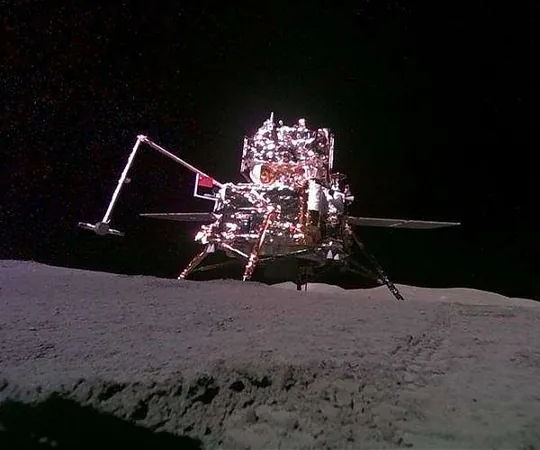
Uncovering the Moon's Secrets: Chang'e-6 Reveals a Turbulent History of Magnetic Field
2024-12-27
Author: Siti
Introduction
A groundbreaking study spearheaded by China's Chang'e-6 mission has unveiled astonishing findings about the Moon's magnetic field, hinting at a dynamic and tumultuous past. This research suggests a remarkable resurgence of the lunar magnetic field approximately 2.8 billion years ago, altering our understanding of the Moon's geophysical evolution.
Significance of the Chang'e-6 Mission
The Chang'e-6 mission provided scientists with the first basalt samples from the Moon's far side, a crucial step in piecing together the historical puzzle of lunar magnetism. While previous studies primarily focused on the nearside of the Moon, leaving several questions unanswered regarding its magnetic evolution, the far side samples have revealed a more intricate timeline.
Research Findings
Under the leadership of Prof. Zhu Rixiang of the Chinese Academy of Sciences and his colleague Associate Professor Cai Shuhui, researchers conducted detailed paleomagnetic analyses. By measuring ancient magnetic fields within the basalt samples, they recorded strengths ranging from 5 to 21 microteslas (µT). These findings painted a picture of fluctuating magnetic intensity, highlighting a significant increase at around 2.8 billion years ago, just after a notable decline observed around 3.1 billion years ago. This revelation challenges the prevailing assumption that the lunar dynamo had significantly weakened and remained inactive after 3 billion years.
Geological Implications
The researchers proposed that the revitalization of the lunar magnetic field could be attributed to a variety of geological forces, including the existence of a basal magma ocean, precessional forces, and core crystallization. These factors suggest that the Moon's interior was not a dormant body but rather remained geologically active through much of its formative years.
Historic Milestone and Future Exploration
This study marks a historic milestone as the first to present paleomagnetic data from the Moon's far side, and by correlating these new results with earlier data, it exposes significant fluctuations in the lunar magnetic field between 3.5 and 2.8 billion years ago. This period appears to reflect a highly unstable dynamo, igniting further questions about the Moon's thermal and geological history.
The implications of these findings extend well beyond academic interest. Understanding the complexities of the Moon's ancient magnetic field could prove invaluable in future lunar explorations and missions. As we gear up to return to the Moon, insights into magnetic field reversals and the Moon’s geothermal past could profoundly influence our approach to exploration and resource utilization on the lunar surface.
Collaborative Efforts
In collaboration with the National Astronomical Observatories of the Chinese Academy of Sciences and with samples courtesy of the China National Space Administration, this pivotal research received support from the National Natural Science Foundation of China, emphasizing the significance of global cooperation in advancing our knowledge of planetary science.
Conclusion
With the Moon as an ever-revealing canvas, these research breakthroughs pave the way for exciting discoveries yet to come. Stay tuned as we continue to uncover the captivating secrets of our nearest celestial neighbor!



 Brasil (PT)
Brasil (PT)
 Canada (EN)
Canada (EN)
 Chile (ES)
Chile (ES)
 España (ES)
España (ES)
 France (FR)
France (FR)
 Hong Kong (EN)
Hong Kong (EN)
 Italia (IT)
Italia (IT)
 日本 (JA)
日本 (JA)
 Magyarország (HU)
Magyarország (HU)
 Norge (NO)
Norge (NO)
 Polska (PL)
Polska (PL)
 Schweiz (DE)
Schweiz (DE)
 Singapore (EN)
Singapore (EN)
 Sverige (SV)
Sverige (SV)
 Suomi (FI)
Suomi (FI)
 Türkiye (TR)
Türkiye (TR)